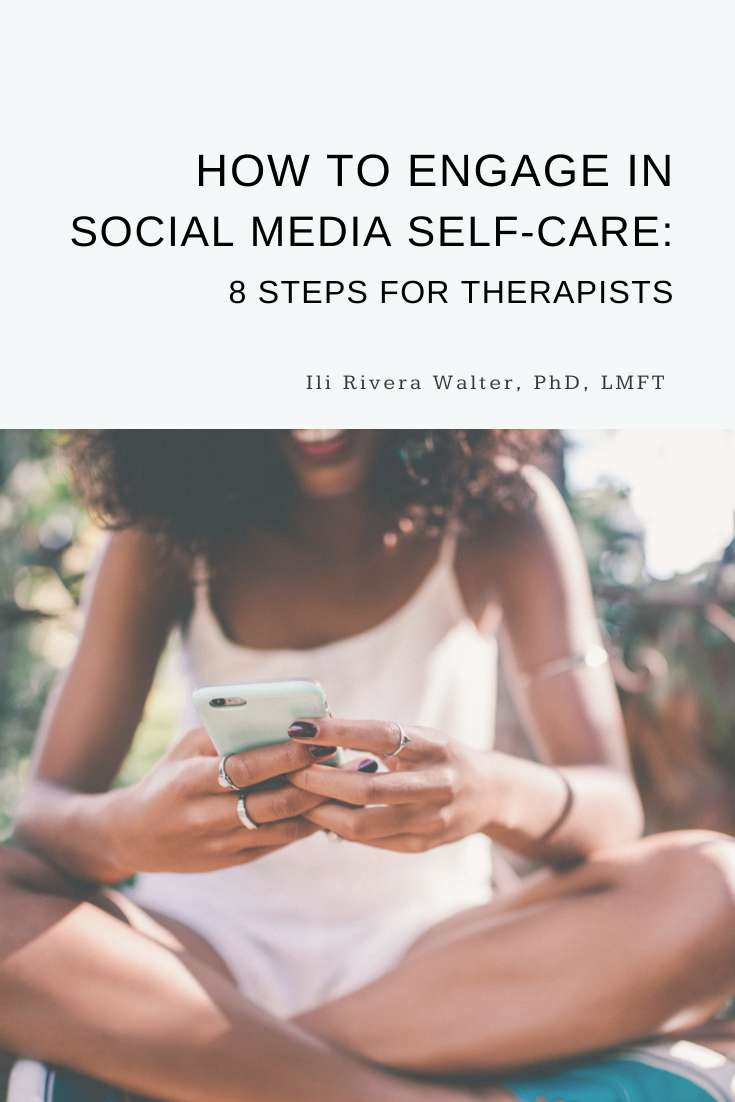This post was originally published on August 17, 2021 and updated on May 18, 2023.
Social media posting is a must if you’re a therapist marketing a private practice. Even if you’re not a business owner, you may find that your social media is taking up more time than you’d prefer (gentle nudge: How’s your screen time report looking this week?).
Hey—like therapy, this is a judgment-free zone. It is also a “let’s be our best selves” zone. And, to show up as our best selves, self care is essential.
When I spend more, unintentional time on social media, I often feel the impact of that choice emotionally and energetically. I've developed a few strategies for myself, so that I am able to approach social media mindfully. Today, I share those strategies with you.
Yes, sometimes we need a break from social media altogether. But, we also need guidelines for engaging on social media in ways that are sustainable (at least, most of the time).
1 | Open your account with a purpose, and leave without lingering
Set a purpose for your engagement. Are you posting, checking DMs, connecting with potential clients, leaving a few comments? Decide your purpose, set a time limit, then hop off.
Social media feeds are enticing. Being prepared, with a time limit, will help keep you on track with your purpose.
Designating a device for social media use can also be a helpful boundary when trying to change your social media habits. Knowing that you only check social media on your phone, for example, and not on your tablet or computer, will automatically contain your engagement.
2 | Notice what's new, but focus on connecting
Whether you run a business or personal account, work to use social media to develop meaningful connections. Briefly peruse new posts from family, or people you admire, and notice the trends and themes. Then, move on to offering praise and support through comments, or DMs, for your loved ones, mentors, and/or potential clients.
3 | Try the CDO rule
Limit accounts you follow to three categories:
Connection: People who matter most (see step #2)
Discovery: Posts that are beautiful or inspiring
Observation: Information that enriches your life, or work
If you follow this guideline, you will automatically curate an account that is restorative, rather than draining.
4 | Share with integrity
Share intentionally.
Whether you’re posting a meme, an Instagram reel, an image, or a tutorial, share only what genuinely matters to you, and what you can support 100% through experience, or research.
Think of your social media account as an extension of your values. How are your posts revealing your vision, mission, and values (individual, or corporate)? Perhaps ask yourself this question before you post, or as you are creating a new post.
Filtering your posts through your values will:
result in ideas for posts, or content, coming more easily to you
keep you focused on specific topics, thereby eliminating confusion about what to post
clearly communicate your expertise
5 | Unfollow. Unfollow. Unfollow.
If a post, or the content of an account doesn't serve you, or your business, or it triggers you in any way, unfollow the account.
The last thing we need is to be pressured into doing more, or being different, by our social media feeds. Give yourself permission to subjugate your social media use to your overall wellness, and embrace control over the messages you allow in your feed.
Further, take the time to filter the content you follow through your current interests and goals. You may have grown past some accounts, or perhaps you find a few topics distracting. Now is the time to unfollow.
6 | Use the “hide ad” feature
When you see an ad, don’t simply scroll by. Notice the ad, and decide if you’d like to see more ads from the company/influencer, or not.
If the ad is irrelevant, or cluttering the feed you are curating, take the steps to eliminate it. On Instagram and Facebook: Click the three dots on the top right of the post, and choose to hide the ad.
7 | Do not compare yourself to other therapists on social media
Comparison can sneak in quickly when we’re on social media.
Crucial to remember, for us, is the fact that social media presents a facade—an image. Yes, maybe other therapists are making a million dollars a year (there are certainly some who are), have 5 streams of income, and actually do have it all together. More likely, these therapists are sharing the wins and not the hardship.
A reminder that I use for myself: “Do what you can, with what you have.” It keeps me focused on my unique purpose, abilities, and desires.
Embrace "no pressure" interactions on social. If you feel pressure, from a post, to have more (followers, income streams, possessions, and so forth), and it's not intentionally aligned with your goals for this season, ignore, or see #5.
8 | Take social media siestas, breaks, and retreats
Sometimes, a self-care strategy is not enough. It may be too little, or too late. We need rest.
When this is the case in your social media sphere, take short or long breaks from your accounts. Create a post that alerts your followers to your decision, and let them know how long you’ll be away. (As an example, see this post by @thesocialchanger on Instagram [originally posted by @blessingmanifesting]).
Put yourself first. Social media can wait.
Inspiration for this post
My ongoing strategies for preserving my mental + emotional wellbeing, while also embracing my love of social media (Instagram, in particular).
The article, "Make Your Social Feeds Friendlier," found in the July issue of Real Simple Magazine.
Let’s Chat
What one tip from this article will you try?
Do you find social media draining? If so, how?














